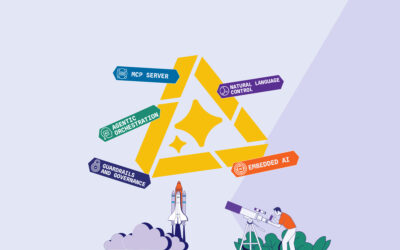As enterprise software evolves from cloud-hosted to cloud-native architectures, systems deployed even a few years ago will need to be replaced to support innovation, speed-to-market, and increasingly sophisticated expectations around customer experience.
When we talk about “legacy systems,” everyone knows we’re talking about software based on dead coding languages, like COBOL, Visual Basic, RPG/400, and technologies like Oracle Forms. Those technologies, once cutting edge, are no longer supported. And yet, many insurers are still using them, despite their many limitations, to operate essential business processes. Those are the legacy systems we all know but no longer love.
Now there’s a new type of legacy system emerging. We call it “modern legacy,” and it’s even more dangerous to an insurer’s wellbeing, not just because the technology is aging, or unsupported, but because it forces insurers to focus inward and invest time, money and effort on workarounds and patches rather than innovation.
We all agree that insurance is being disrupted by insurtechs, IoT, cloud, and other new data sources and technologies that will take us from 2020 to 2030 and beyond. And yet many insurance core systems, even those built just five years ago, have serious limitations baked into their very architecture. Archaic insurance core systems not built on cloud-native architectures lack the essential openness necessary for insurers to quickly, easily, and inexpensively connect with insurtechs, new data sources and systems, join digital insurance ecosystems, and offer the digital customer experiences that people now demand.
Watch Video: What is modern legacy? from EIS on Vimeo.
Cloud-Native Architecture Matters
Industry analysts describe the architecture of many of those insurance core systems as “monolithic,” which — thanks to “2001: A Space Odyssey” — instantly conjures a pretty accurate picture: immense, opaque, mysterious, and impenetrable. Very simply, they were designed to satisfy the requirements of a bygone era. The very idea of joining a digital insurance ecosystem or extending self-service opportunities to the insured, for example, just didn’t exist when they were built. As a result, they don’t sport the microservices and open application programming interfaces (APIs) that are now essential to satisfying expectations for contemporary customer experiences.
Further, the beating heart of modern legacy systems is the policy administration system. And all downstream applications, from billing and claims to reporting and analysis, are built around policy records, not customer records. For many insurers, this has necessitated workarounds, such as data lakes, MDM projects, and CRM applications, to understand customer histories better, act on them in the moments that matter, and offer self-service opportunities to insureds, agents, and brokers. All of which is critical to delivering on the customer-centric future of insurance.
To buy some time and increase “curb appeal,” many vendors now stuff their modern legacy systems into the cloud and slap on a “SaaS” label. But don’t be fooled by cloud-based delivery. As insurers are now finding out, even with the benefit of managed services, you can’t just put those old systems in the cloud and expect them to deliver on the real benefits of SaaS (scalability, reduced time-to-value, lower costs, automatic updates, etc.). Cloud-native architecture matters. Hosting a modern-legacy system in the cloud and calling it SaaS will not help insurers succeed in a future based on ecosystems, self-service, and customer-centricity.
Lastly, these modern legacy systems are deployed using waterfall methodologies, and so they’re time and resource-intensive implementations that result in already outdated software. It’s a final bit of irony, really, that after all that effort to transform and modernize, the resulting implementation lacks the updates and capabilities issued since the application was purchased.
If they don’t already, modern legacy systems soon will seem as old school as an AS/400. And insurers will need to go back to the table — yet again — to achieve those goals: openness, speed to market, speed to value, customer-centricity. That’s the danger of modern legacy.
Coretech: New Technology and Strategies for the Digital Transformation of Insurance
Insurers, analysts, and vendors have a good idea about what the future of insurance core systems will look like. The new generation of insurance core systems, aka coretech, is built on cloud-native/SaaS architectures (microservices, CI/CD {continuous integration and continuous delivery}, containerization, etc.). It’s customer-centric, fully-digital, and built with open APIs to connect core systems, data, insurtechs — anything, really — so that you can become the insurer that you want to be. Not just the insurer your system tells you to be.
But the truth is that technology isn’t going to solve all the culture and process problems. All of that needs to come together. And for EIS, it is. As an industry, all of us have seen core systems replacement projects fail, and the number one reason is that they take too long. Three years? While not uncommon, that’s an eternity. Even one year is too long. And rather than the old rip ‘n’ replace, we’re seeing two transformation strategies take hold with insurers.
Greenfield Innovation Produces Quick Wins for Insurers
The first is what we call a “greenfield approach.” Ultimately, the insurer wants to accomplish an overall digital transformation. But what we’re doing is focusing on the new, whether it’s a new insurance product, market, or distribution channel.
In short, we install the platform and get the insurer up and running in three to six months, depending on the project. We make sure they’re processing that new business and getting the value right away. Then the insurer begins to see what success looks like. They build on that success, and it starts to change the culture. The insurer becomes the expert in the new system and applies that expertise to the next big project or block of business. We have four customers who have deployed EIS that way.
Watch Video: What EIS Does from EIS on Vimeo.
The Roll-up Produces Operational Efficiencies, Consolidated Data and Lowers Risk
The other strategy, I’ll call it the roll-up strategy, will interest insurers with many lines of business and even multiple core systems. Here’s a real-life example.
We’re working with one of the largest carriers in Canada. They have more than 15 million customers and eight modern legacy insurance core systems. One of their major goals is to create a centralized 360-degree view of each customer across all of their product lines, which are on multiple systems.
First, they installed BillingCore®, our enterprise billing capability, and our CustomerCore™ module, which they are now using as the endpoint of their MDM (master data management) activity. Then they put all of their customer records into our platform. They’re going live with 15 million customer records on our platform in the cloud this fall. It will be among the largest cloud-native implementations globally.
This will immediately help them deliver a much better customer experience through a single call center. For the first time, they will be able to see all of the policies each customer owns, understand their whole relationship with that customer, and begin cross and up-selling. They will have solved a major problem without having to do the nasty bits of a data conversion, and they’ll immediately be getting great value.
Next, they’ll implement our PolicyCore® and ClaimCore® applications for that first line of business. Then they start on the next legacy line of business. Over time, they can replace each of those legacy systems with much less pressure.
Insurers now have no excuses. It’s not a three-year project, or even a one-year project. They can begin seeing a return on their investment literally within months.
If you’re ready to learn more, watch Are We Stuck on Legacy Core Systems Forever? In which industry experts discuss what they’ve learned from insurers who have tried and failed to transform their businesses, as well as alternative strategies for success.




